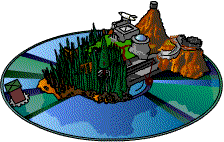Myst - the Computer Game
Created | Updated Jan 23, 2014

Myst, the computer game, released in 1993, is an adventure game conceived by brothers Rand and Robyn Miller, developed by their company, Cyan, and published by Red Orb. It was one of the first attempts at making an adventure game in a photo-realistic visual format, rather than in the more traditional text interface (as in Multi-User Dungeon online gaming) or in the cartoonish, unrealistic style that was the staple of visual game formats at the time. It is also notable that it is a non-violent game, made in a time when shoot-'em-ups were quite popular, and it was very hard to find non-violent games aimed towards adult tastes. It was a success with non-gamers, mostly, and it was primarily these uninitiated who made Myst a best-selling phenomenon, despite its modest budget. Another factor that affected its chart-topping sales growth for years to come was various licensing agreements Red Orb had in place to ensure the game was included with new computers, new CD-ROM drives, or other hardware devices.
Myst
The opening sequence does not answer questions. It does not tell you the background story of Myst, how it came to be, or what you have to do there. It features a disembodied voice rambling about a book and endings and such while you see a graphic of a book falling. Until, of course, the book hits the ground. Upon opening the book, there is nothing to read, just a picture of a dock and the ocean beside it. The picture moves. With not a whole lot else to do, the player is expected to 'touch' the image...
...and then you're there. No one jumps out to shoot you, no one comes to offer you a tour, and after a quick look around, you realise that there is no one there.
A Visually Appealing World
Enough could not be said about how utterly tangible Myst felt to its fans.
The world of Myst is viewed in a slide show format. You would not turn to look to the right as much as you would turn and see what was to your right, as 360° views were still something of a novelty in gameplay. Myst was essentially made up of still pictures, often imbued with Quicktime plug-ins to let the player alter their environment and solve puzzles.
To younger, more savvy game players who do not remember a world before 3D accelerators became the norm, when 256 colours seemed like more than anyone could ever use, Myst seemed to go a step further by not using hokey animated figures. But Myst was made so that almost anyone could enjoy it, not just those with high-end processors and loads of memory to spare. And yet, at the same time, Myst broke down graphic barriers, using real people1 to play out the very real-feeling characters in the game, and textures so rich with colour that the real, everyday world seemed to lack some depth after bouts of extended gameplay.
Ear Candy
How could one make a world so beautiful, only to have it fall silent? Myst was quiet... but nowhere near silent.
Having only a shoestring budget, fancy recording studios were out of the question. Chris Brandkamp stepped in, and with the use of everything from crescent wrenches to plastic-wrapped microphones submerged in toilets he made the world of Myst come alive with sound.
Sound effects contributed to the overall realism in Myst, but the haunting score made it an emotional experience. Originally, the Miller brothers opted for no music in their game, thinking that music would be somewhat of an 'overkill' on their rather delicate project. Convinced of this, Robyn Miller wrote a short piece of music (via midi) to accompany the opening sequence of the game to once and for all prove to himself, his brother, and everyone else evolved, that Myst did not need, and would not benefit from a soundtrack. Less of a song and more like an audio representation of Myst itself, the track was immediately added to the game, and music for every other part of Myst was written by Robyn, all with the same haunting, mysterious, ambient, and dark sound in mind.
Beyond Myst
The Myst story is continued in Riven: the Sequel to Myst, and further continues in Myst III: Exile, Myst IV: Revelation and Myst V: End of Ages. There's also a Myst Uru which is similar but not considered to be part of the series.
The gaps in the history of the Myst world are filled in by a series of novels2. The trilogy begins with Myst: the Book of Atrus which tells of how Atrus, Myst, and almost everything else within Myst and Riven came to be. The trilogy continues with Myst: the Book of Ti'ana which tells the story of the fall of the D'ni race, and of Atrus' grandmother (who came from the surface of our world), and in the third book, Myst: the Book of D'ni, Atrus attempts to rekindle the D'ni empire, but comes across the little-known dark side of D'ni culture on the way. There has been a buzz about books being added to the trilogy, but nothing has been printed, yet. They're pretty good reads if you're at all interested in what happened in general/before/or after Myst, and like fast-paced, well-written fantasy.
Myst for the New Millennium
Since the release of the original Myst, there have been updated versions. Myst Masterpiece corrects a few gameplay problems, and boasts true-colour depth, as opposed to the original's 256-colour (yet beautifully rendered) graphics. Unreleased at the time of writing is a project called realMyst which will reportedly feature changes in weather (clouds darken the skies, rain falls, lightning strikes...), changes in the time of day (have you ever seen Myst at sunset?), full 360° views of the landscape, and a generally more immersive gaming experience.

